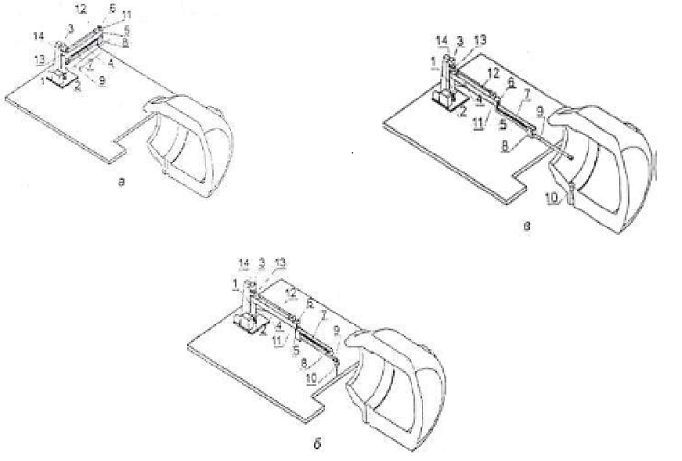Abstract
Содержание
- Introduction
- 1. Theme urgency
- 2. Goal and tasks of the research
- 3. Description of construction
- Conclusion
- References
Introduction
The converter method of production is one of the main
ways of obtaining
steel and an integral part of the modern metallurgical industry. The
task of
high-quality steel production is to reduce the amount of slag that
falls into
the steel ladle bucket. There are various ways to cut off converter
slag:
gas-dynamic cutoff, using gate types of various types, using cut-off
elements.
1. Theme urgency
Let us consider a method with the use of float type
cut-off elements. To insert them into the bath of the oxygen converter,
special
manipulators are used. Most widely used are the designs of Monocon
International Refractories Ltd. (http://www.monocon.info) and Yuntian
Metallurgy Technology Co., Ltd. (http://ytslagstopper.com). Such a
multitude of
design versions is characterized by production and technological
features of
the work sites of oxygen converters.
2. Goal and tasks of the research
Based on the
analysis of the analysis of design features of existing manipulators:
1) develop a
design with a minimum number of drives;
2) to develop a
universal design of the manipulator, for various production conditions;
3) analyze the
operation of the manipulator with various variants of the combinations
of
drives;
4) evaluate the
effectiveness of the application of combinations of drives;
3.Description of construction
The design of the axial-type manipulator for inserting
the cut-off
elements into the steel outlet of the converter when the steel is
discharged is
shown in Figure 1. This manipulator includes a vertical column 1
rotatably
mounted in the lower 2 and top 3 fixed bearing supports and equipped
with a
bracket 4 on which the bearing assembly is mounted 5 with a vertical
shaft 6.
At the lower end of this shaft, the bracket 7 is rigidly fixed, having
two
longitudinal guides, in which are placed the rollers of the carriage 8,
The
locking mechanism of the bracket relative to the console includes a
bevel gear
pair 11 with a gear ratio of 1 connecting the vertical shaft to the
rear end of
the horizontal shaft 12 at the front end which is rigidly fixed to the
bevel
gear 13, which is able to roll over the bevel gear 14.
This pinion is rigidly connected to the fixed upper support of the vertical column. And the ratio of the number of teeth of the fixed bevel gear and the bevel gear is 2: 1. These ratios of the structural elements of the bevel gears allow to automatically provide simultaneous rotation of the column with the console to a corner of 90 degrees, from the initial position the relative rotation of the bracket by 180 degrees, as a result of which the bracket and the bracket will be aligned in a line and occupy the coaxial position with the oxygen converter, kick is shown in Fig. 1b. Subsequent delivery of the cut-off element to the zone where the converter outlet is located (Fig. 1c) is carried out by moving the carriage with the hollow rod relative to the bracket using a chain drive.
Figure 1 - Device axle type manipulator and the location
of its elements
in the source (a), intermediate (b), and final (in) positions
Conclusion
Thus, analyzing the design features of manipulators of
foreign firms, we
can distinguish a number of distinctive features:
1) Each of them in its composition has at least two
drives, one - to
exit the parking position, the rest - to carry out the work operation
to put the
rod with the cut-off element into the cavity of the oxygen converter;
2) The design of each manipulator is individual, adapted
to certain
production conditions;
3) Some structures even in the parking condition have
large dimensions;
4) A number of designs can only be used for newly built
converter shops.
The design of the manipulator of the department
"Mechanical
equipment of ferrous metallurgy plants. professor Sedush V.Ya.
»has a lower
power consumption, smaller dimensions, and can be used and adapted for
different locations with respect to the oxygen converter.
References
- Опыт разработки систем отсечки шлака для сталеплавильных агрегатов / С.П. Еронько, А.Ю. Цупрун, С.А. Бедарев, С.В. Мечик // «Черметинформация». Бюллетень «Черная металлургия», 2007. – вып. 9, – С. 81 – 87.
- Еронько С. П., Смирнов А.Н., Кукуй Д.П. Разработка эффективных схем отсечки шлака при сливе металла из конвертера // Металлургическая и горнорудная промышленность. - 2003. - №8. - С. 33 – 37.
- Опыт разработки систем отсечки шлака для сталеплавильных агрегатов / С.П. Еронько, А.Ю. Цупрун, С.А. Бедарев и др. // ОАО «Черметинформация». Бюлл. «Черная металлургия» - 2007 - № 9 - С. 81 – 87.
- Исследование напряженно-деформированного состояния звеньев манипулятора для ввода отсечных элементов в выпускной канал конвертера / Еронько С.П., Ошовская Е.В., Бедарев С.А., Мечик С.В. // Металлургическая и горнорудная промышленность. – 2007.– №5. – С. 107 – 111.
- Теплофизические свойства веществ. Справочник / Под ред. Н.Б. Варгафтика. – Л.: Гос.энергетическое изд-во, 1956. – C. 367.
- Использование математического моделирования и САПР при разработке устройства устройства для отсечки конвертерного шлака / С.П. Еронько, Е.В. Ошовская, В.В. Киселев и др. // Прогрессивные технологии и системы машиностроения: Сборник научных трудов - Донецк: ДонГТУ, 2002 - № 23 - С. 52 – 56.
- Исследование напряженно-деформированного состояния звеньев манипулятора для ввода отсечных элементов в выпускной канал конвертера / Еронько С.П., Ошовская Е.В., Бедарев С.А., Мечик С.В. // Металлургическая и горнорудная промышленность. – 2007.– №5. – С. 107 – 111.

